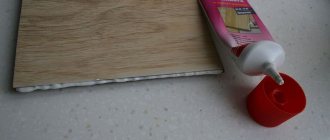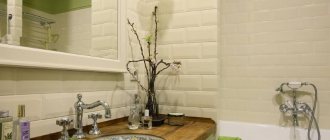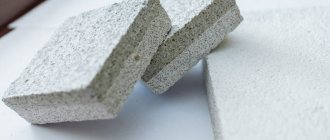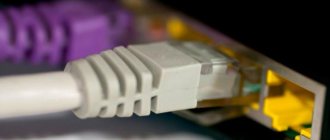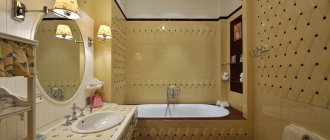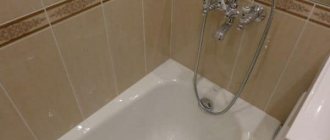| Place | Name | Characteristics in the rating |
| The best silicone sealants |
| 1 | Kim Tec Silicon Acetate 101E | The optimal combination of low cost and excellent quality |
| 2 | Dow Corning 7091 | The best sealant for shower enclosures |
| 3 | Ravak Professional (white) X01200 | Better adhesion and fast drying |
| The best sanitary sealants |
| 1 | MAKROFLEX SX101 | The best sanitary sealant |
| 2 | Belinka Belsil Sanitary Acetate | Ideal for ceramics |
| 3 | TANGIT S 400 | High resistance to mold |
| The best acrylic sealants |
| 1 | Ceresit CS 7 | Better seam elasticity |
| 2 | Moment Germent | Ideal for wide seams |
| 3 | VGP acrylic white, 310 ml | Universal sealant for bathtub and whole house |
| The best universal sealants |
| 1 | IRFix MULTISEAL 310ml | Suitable for a wide range of applications |
| 2 | MASTERTEKS PM universal 290ml white | Fast hardening and excellent adhesion |
| 3 | Adhesive-sealant Quelyd “007” | Replaces all types of sealants |
The sealant is a paste-like product whose purpose is to waterproof and seal. Sealants play a special role in the bathroom - they are used to seal joints between tiles, as well as joints between tiles and a bathtub or shower. With their help, it is possible to achieve a more aesthetic appearance and give the renovation completeness. An additional function is protection against condensation, splashes and high humidity, which contribute to the development of pathogenic fungi and bacteria.
We present to your attention a rating of the best sealants. When choosing, the following characteristics and indicators were taken into account:
- setting speed of the composition;
- ease of removal after drying;
- brand value and prevalence;
- mildew resistance;
- consistency;
- degree of adhesion - the quality of adhesion with other materials.
Errors in use, or Why sealants are not liked on forums
Sealant for builders and repairmen in Russia is a subject of heated debate, that very unfortunate new product that divides specialists into conservatives and innovators. Someone, having positive experience, recommends sealing the seams with sealant: it is both convenient and practical. So why are there negatively-minded specialists? Everything is logical: there really are problems with the sealant, and most often they relate to errors in use. And you can’t blame people for this: sealants are a “white spot” on the Russian market. Manufacturers, as a rule, don’t tell much about their product, and therefore they end up with bad experiences: as they say, they did what they did. In this material we will try to highlight the most common “hermetic” problems that are discussed on construction forums.
Rating of the best bath sealants
| Nomination | place | Name of product | price |
| The best acrylic sealants | 1 | Ceresit CS 7 | 290 ₽ |
| 2 | Moment Germent | 449 ₽ | |
| The best sanitary sealants | 1 | MAKROFLEX SX101 | 252 ₽ |
| 2 | Tangit SPECIAL S400 | 189 ₽ | |
| 3 | Belinka Belsil Sanitary Acetate | 216 ₽ | |
| The best silicone sealants | 1 | CIKI FIX universal | 120 ₽ |
| 2 | KRASS silicone universal | 199 ₽ | |
| 3 | Ceresit CS 25 | 290 ₽ | |
| The best polyurethane sealants | 1 | Tytan Power Flex | 480 ₽ |
| 2 | Rubberflex PRO PU 25 | 298 ₽ |
In what types of exterior work do sealants work well?
Today, sealants are widely used in external and internal construction and repair work:
- for filling and sealing expansion joints in industrial floors;
- for filling and sealing horizontal and vertical joints of building facades;
- for expansion joints of buildings and structures, including those that are constantly under water;
- for sealing seams and joints of wall and roof sandwich panels;
- for sealing corner and wall joints in factory-made façade concrete slabs, ceramic tiles, and metal surfaces;
- for sealing inter-crown joints in buildings made of rounded logs and timber;
- for filling cracks and crevices;
- for sealing and sealing any connections, including those made of dissimilar materials;
- for fastening roofing materials and sealing the roof;
- for sealing connections of sanitary products in bathrooms;
- for sealing passages of utility lines, including structures that are subject to vibration;
- for sealing and waterproofing any seams, joints, junctions, holes;
- for installation of double-glazed windows.
This article will discuss the types of sealants for outdoor use.
What compositions are suitable for the kitchen
This is a complex room, in which there are areas with high humidity and temperature changes, where furniture and building materials require special protection. When connecting the sink and faucet, only moisture-resistant preparations are used. The selection rules are similar to those in the bathroom. The pipes are treated with a product that will not destroy them.
In the kitchen, it is necessary to seal the joints of the countertop and apron, furniture cuts, and edges. To do this, choose moisture-resistant pastes marked “sanitary”. They contain substances that prevent the development of mold and fungi. Therefore, the seams will not darken over time. If the color of the mastic is important, select a suitable tone or paint it with acrylic paint after drying. But we must remember that not all products can be painted.
If the hob cuts into the countertop, the joint must also be sealed. True, not all craftsmen do this, explaining that moisture does not get under the equipment. In fact, it’s better to play it safe and process the cut. It is important to choose the right sealant to use for your cooktop. Only heat-resistant silicone paste will do. You need to place the device on it so that there are no problems with the countertop swelling.
Classification
Depending on the composition, all silicone-based sealants are divided into two large groups:
- One-component . Cures under the influence of atmospheric moisture. All compounds used in everyday life belong to this class. In this case, the thickness of the seam or layer should not exceed 10 - 12 mm.
- Two-component . To harden, the sealant requires a special catalyst, which is added before application. Curing occurs in a volume of any thickness. Due to its specifics, it is used only in industry and large-scale construction, and is produced in large containers.
Also, various substances may be involved in the chemical reaction that occurs after applying the sealant. Based on their presence in the composition, sealants are divided into:
- Acidic . I have a distinct smell of acetic acid. Manufacturers recommend working with the compounds wearing masks and gloves, and also ventilating the room well. After curing, they have no odor, since the entire substance participates in the reaction. The advantage is low cost and widespread distribution, but there are also disadvantages. Due to their acidic reaction, such compounds are not suitable for sealing metal products and some cementitious compounds (which contain alkaline elements).
- Neutral . Instead of acids, they contain substances based on alcohol or methoxy group. They are distinguished by a weak odor or its complete absence. They do not irritate mucous membranes, are harmless for inhalation, and are chemically inert towards surfaces. The only negative is that they are expensive due to the peculiarities of their composition and production.
Thanks to additional substances, manufacturers can slightly influence the properties of the final product, which determines the specialization of a particular sealant. The following options are available for sale:
- Sanitary . Designed for use in bathrooms and washrooms. The main purpose is waterproofing while maintaining a pleasant appearance. Contains special additives that prevent the spread of fungus.
- Automotive . It is black or red in color and is available in tubes. It is used to insulate parts that heat up to high temperatures; in some cases they can replace paronite gaskets. It is used in the areas of fastening oil pans, exhaust manifolds, cylinder heads and other mechanisms.
- Aquarium . Transparent neutral sealant with the most neutral composition. Good adhesion to glass, completely hypoallergenic.
- Electrical insulating . It is used in critical places where electrical conductors are located.
- High temperature . Unlike automotive, it is used in construction, for working with seams and junctions in swords, fireplaces, exhaust pipes of heating devices, fireplace aprons and other places with high temperatures.
- Universal . Available in a variety of colors to match the material being applied. It has average parameters and is widely used in construction and repair.
Question answer
How to store started sealant?
Always screw the spout on tightly. Silicone sealant hardens when exposed to atmospheric moisture. The tighter you twist it, the better.
How to get a “sausage” of the required thickness?
To do this, the dispenser spout is cut off in accordance with the dimensions of the cavity, gap or joint. It's always better to cut less. You can also get a thicker layer by slowly moving the tube so that more of the composition is squeezed out.
How to apply sealant evenly and beautifully?
To do this, use two strips of masking tape glued on both sides of the seam.
How to smooth silicone sealant without getting dirty?
The best tool is your finger, it will give you the most accurate sensations. To prevent the sealant from sticking, wet the skin with plain water.
Application specifics
Silicone sealants are actively used for installing doors, metal structures, window frames, sealing showers and bathtubs, and sealing water supply connections in the kitchen. Special compounds have been created for working with glass products and surfaces.
To use sealant, you do not need to have special skills or special education. The main thing is to follow the manufacturer's recommendations. The composition must be applied using a special gun onto a dry, clean and previously degreased surface. Setting period – 30 minutes, hardening time – 24 hours. After completing the work, wash off the excess substance from your hands with a soap solution, and from the surface with a damp cloth.
More about construction and renovation
All articles
Soudal Soudaseal 240 FC
The Belgian-made sealant has a polymer base and is characterized by high adhesion, which allows the product to be stretched eight times before being cut off. The sealant is suitable for working with metal, plastic, glass, acrylic enamel, tiles and perfectly seals the cracks in the joints between the tiles and the bathtub. On sale there is a different choice of volumes for 290 and 600 mm, and the choice of colors is distinguished by white, gray and black.
Pros:
- High adhesion and elasticity;
- There is a choice of three colors;
- Good water resistance;
- Universal purpose;
- Protects against fungus
Minuses:
- A long period of polymerization or, simply put, drying.
Ceresit CS 15
Silicone sanitary sealant is one of the most popular. There are only two colors on sale: white and transparent, which comes in a classic pistol tube. The sealant will be able to adhere to the tile, effectively seal the joint between the bathtub and the tile or plastic; it is also suitable for glass.
Pros:
- High adhesion;
- High abrasion rates;
- High strength and elasticity;
- Affordable and popular product.
Minuses:
- Not very distinguished by high levels of resistance to fungus.
No. 8. Thiokol sealants
Thiokol (polysulfide) sealants are considered one of the most durable, durable and expensive compounds. As a rule, such sealants consist of 2-3 components (base, curing paste and vulcanization accelerator), which are mixed in specified proportions before use. The resulting composition must be used within two hours, complete hardening occurs from several hours to a couple of days.
Advantages:
- high elasticity;
- the highest resistance to aggressive substances, gasoline, kerosene, oils, which allows the sealant to be used in garages, gas stations, laboratories, etc.;
- resistance to precipitation, UV rays, as well as a wide range of temperatures (from -50 to +1300C);
- high adhesion to concrete, reinforced concrete and metal, which makes it possible to use sealant when repairing metal roofs;
- durability.
Flaws:
- high price;
- the need to use protective equipment during work;
- the need to carry out all work on applying sealant very quickly.
Table of advantages and disadvantages of different types of bathtub sealants
| Types of sealants | Advantages | Flaws |
| Acrylic | + low price + moisture resistance and resistance to temperature changes + can be painted + excellent adhesion to different materials | - insulation is not elastic — hardens for a long time (24 hours) - not all products are suitable for the bath |
| Sanitary | + high resistance to biodestruction + wide scope of application + good adhesion + minimal shrinkage | - pungent odor lasts for a long time - high price |
| Silicone | + affordable price + resistance to water, temperature changes, ultraviolet rays + wide range of colors + also suitable for outdoor use | - cannot be painted — insufficient adhesion to polymeric materials. |
| Polyurethane | + fast hardening + can be used as an adhesive + elastic and durable insulation + can be coated with paint or varnish | - high price - poses a danger to the health of the finisher during work |
Kinds
Paste-like products are divided by price and scope of application. The following classification is provided.
Acrylic
One of the cheapest sealing compounds. However, their technical characteristics are not inferior to expensive options. Pros of acrylic sealants:
- There are no dangerous or toxic components in the composition.
- Suitable for most surfaces (concrete, brick, plastic, metal, glass, wood).
- Possibility to choose a sealant with a wide and narrow temperature range (from -20 degrees to +80).
- Once the seam polymerizes, it loses its elasticity and becomes stronger.
- Dries quickly, which simplifies the installation process.
- If the surface has cooled, it can be coated with varnish or paint.
Many people choose acrylic materials because they do not require protective equipment when working.
But the disadvantage of the material is that it shrinks during drying. Therefore, when water gets on the seam, leaks begin.
Acrylic sealant should only be used in areas where there is virtually no liquid penetration. Also, for a leak-proof seam, you need to apply a primer before application. This will ensure better adhesion.
The material is used in the following areas:
- when filling cracks and voids in concrete, brick;
- for attaching cracks between jambs or walls made of different materials (brick, concrete);
- for processing unprotected edges of furniture.
Applying sealant
If water gets on the building material, it will begin to darken. Therefore, it is not advisable to buy white. It's better to take a colored one. The changes on it will not be very noticeable.
Silicone
One of the most popular types. They are acidic and neutral in composition. The first ones are cheaper. However, it is impossible to work with them if the room is closed. Until the material hardens, there will be a strong odor in the room.
Also, acidic silicone sealants cannot be applied to metal, as it oxidizes. If the bathtub is cast iron or steel, you should choose a different product.
Any silicone sealant, whether acidic or neutral, may or may not be waterproof. Waterproof ones are better suited for the bathroom. Silicone materials are divided into one-component and two-component. It is preferable to choose the first type, as it does not require mixing.
Features of silicone sealants:
- Good adhesive ability. Can be used to seal joints on window sills. Suitable for installing countertops and sinks.
- Tolerates high temperatures. Used to seal drains near the chimney.
Silicone sealants
Polyurethane
Suitable for outdoor use. The surface will not deteriorate if moisture gets on it. Also withstands high temperatures and ultraviolet rays.
Polyurethane sealant does not turn yellow, so you can choose white. Another feature of the type is that it is called sanitary. It has excellent antifungal properties. In addition, this sealant is odorless.
Peculiarities:
- acquires elasticity after drying;
- no shrinkage when drying;
- can be painted;
- good adhesion to almost all materials.
Polyurethane sealant
The best polyurethane sealants for bathtubs
One of the most modern types of bathtub sealants are polyurethane-based compounds. The products do an excellent job of insulating joints in glass, wood, stone, concrete, and ceramics. The seam hardens quickly and is resistant to microorganisms, moisture and temperature changes. Experts singled out two products from the total mass.
Tytan Power Flex
Rating: 4.9
Polish polyurethane sealant Tytan Power Flex is a professional insulating material. Experts confirm flattering user reviews regarding high performance properties. The product deserves the highest level in our rating. Among the many positive qualities, experts highlight the elasticity and strength of the formed insulation layer. The sealant is equally good at filling tile joints or eliminating voids in plumbing fixtures.
There is one more feature of the composition; it can be used to restore old seams or joints. Thanks to reliable adhesion, durability and the possibility of painting, the consumer can fit the new panel into the interior of the bathroom at minimal cost.
Advantages
- high quality;
- elastic and durable seam;
- possibility of restoration of old connections;
- high adhesion.
Flaws
- high price.
Rubberflex PRO PU 25
Rating: 4.8
The one-component composition Rubberflex PRO PU 25 is not very well known in our country, although its qualities are worthy of attention. It’s not for nothing that experts gave this polyurethane sealant second place in the rating. Experts attribute the increased elasticity of the seam to the strengths of the product. After the layer dries, high-quality insulation is formed. The composition can be used when installing plumbing fixtures or for decorating tiled surfaces.
Users speak flatteringly about the product’s resistance to negative atmospheric conditions. The composition can be used both for interior work and for finishing external surfaces. To highlight the beauty of the interior, the insulation layer can be painted in a suitable color. If the seam is damaged, the integrity can be easily restored with the same sealant.
Advantages
- elastic seam;
- resistance to precipitation and sunlight;
- no shrinkage.
Flaws
- rarely on sale;
- high price.
Features of the material
The basic component in the manufacture of this type of material is silicone rubbers - viscous compounds, the main chemical element of which is silicon. Thanks to various additives and additives, silicone sealants can differ significantly in physical properties, color, ductility, and characteristics of interaction with surfaces. At the same time, they retain their main inherent advantages:
- good adhesion to most materials;
- dense structure without pores and cavities;
- ability to work at high and low temperatures (total range from -50 to +300°C);
- high elasticity rates;
- chemical inertness after curing;
- resistance to ultraviolet spectrum of sunlight and lighting devices.
Together with a wide range of visual designs (various colors, as well as their complete absence), these properties have provided silicone sealants with enormous popularity in construction, repair, automotive and other areas.
Most construction sealants are packaged in plastic tubes with a spout and a movable bottom for use in matching pistol-type syringes. For closed devices, it is permissible to use materials in soft packaging (foil bags). Automotive sealants are often produced in tubes, from which they are squeezed out by hand.
Problem #8. The most painful problem is that the sealant crumbles, cracks and falls off.
Solution. This could be due to four reasons:
- Expired sealant.
- The surface contains a finish that is incompatible with the sealant, such as paint. It is advisable to completely clean the seam of other finishing materials before sealing, leaving the “native” surface, that is, do not apply sealant to either paint or mastic.
- Incorrect installation of sealant. If the seam is very deep, then it is not always possible to fill it 100%, since we cannot see what is inside. And inside there remains a space with air, which leads to cracking of the already hardened sealant. To prevent this from happening, you need to place a sealing cord in such seams, and then fill them with sealant. The second feature is unstitched seams. If this is, for example, a crack, then it is often uneven: on the surface it may appear narrow, but from the inside it expands, bends, crumbles and crumbles. Therefore, such seams must be unstitched and cleaned, that is, with a spatula or other tool, remove what is being removed. Tap, try to knock out everything you can, and then fill the completely cleaned seam.
- Incorrect sealant selected. Operating conditions determine the choice of sealant: for damp places - sanitary, for facades - frost-resistant, for window openings and wooden houses - with high elasticity. Often the seam cracks due to movement and lack of elasticity, so select a sealant with an elasticity of at least 15%. It is necessary to look at the instructions: will the composition withstand moisture, cold, deformation.
